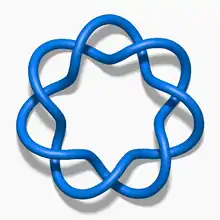Unknotting number
In the mathematical area of knot theory, the unknotting number of a knot is the minimum number of times the knot must be passed through itself (crossing switch) to untie it. If a knot has unknotting number , then there exists a diagram of the knot which can be changed to unknot by switching crossings.[1] The unknotting number of a knot is always less than half of its crossing number.[2]

Trefoil knot without 3-fold symmetry being unknotted by one crossing switch.

Whitehead link being unknotted by undoing one crossing
Any composite knot has unknotting number at least two, and therefore every knot with unknotting number one is a prime knot. The following table show the unknotting numbers for the first few knots:
 Trefoil knot
Trefoil knot
unknotting number 1 Figure-eight knot
Figure-eight knot
unknotting number 1 Cinquefoil knot
Cinquefoil knot
unknotting number 2 Three-twist knot
Three-twist knot
unknotting number 1 Stevedore knot
Stevedore knot
unknotting number 1 6₂ knot
6₂ knot
unknotting number 1 6₃ knot
6₃ knot
unknotting number 1 7₁ knot
7₁ knot
unknotting number 3
In general, it is relatively difficult to determine the unknotting number of a given knot. Known cases include:
- The unknotting number of a nontrivial twist knot is always equal to one.
- The unknotting number of a -torus knot is equal to .[3]
- The unknotting numbers of prime knots with nine or fewer crossings have all been determined.[4] (The unknotting number of the 1011 prime knot is unknown.)
Other numerical knot invariants
See also
References
- Adams, Colin Conrad (2004). The knot book: an elementary introduction to the mathematical theory of knots. Providence, Rhode Island: American Mathematical Society. p. 56. ISBN 0-8218-3678-1.
- Taniyama, Kouki (2009), "Unknotting numbers of diagrams of a given nontrivial knot are unbounded", Journal of Knot Theory and its Ramifications, 18 (8): 1049–1063, arXiv:0805.3174, doi:10.1142/S0218216509007361, MR 2554334.
- "Torus Knot", Mathworld.Wolfram.com. "".
- Weisstein, Eric W. "Unknotting Number". MathWorld.
External links
This article is issued from Wikipedia. The text is licensed under Creative Commons - Attribution - Sharealike. Additional terms may apply for the media files.